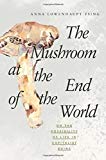Kamil Ahsan at The Millions:
 For the burgeoning fields of environmental humanities, it has long since become a commonplace notion that there isn’t really any such thing as “nature” or “wilderness”: both words used to connote real places—pristine and untouched places—but with the increasing knowledge that such a state of being likely never existed, the words come up empty. There are, however, new narratives: Through a case study of the global matsutake mushroom trade, anthropologist Anna Tsing shows compellingly in The Mushroom at the End of the World that the human-disrupted landscapes we find everywhere are worthy of study.
For the burgeoning fields of environmental humanities, it has long since become a commonplace notion that there isn’t really any such thing as “nature” or “wilderness”: both words used to connote real places—pristine and untouched places—but with the increasing knowledge that such a state of being likely never existed, the words come up empty. There are, however, new narratives: Through a case study of the global matsutake mushroom trade, anthropologist Anna Tsing shows compellingly in The Mushroom at the End of the World that the human-disrupted landscapes we find everywhere are worthy of study.
How far do we have to look to find that in the stories we tell today? Not far at all. Lauren Groff’s collection of stories, Florida, seems to see every landscape it describes as contaminated—the wreckage of things wrought by both humans and non-humans. In “Dogs Go Wolf”—a survivalist tale of two sisters stranded on an island, abandoned and threatened by adults—more than monkeys, more than dogs, it is a menacing man from whom the sisters hide. “He moved toward the boat and kicked it once, twice, then the girls saw the rotten wood break apart, and a hundred frightened bugs ran out.”
more here.
